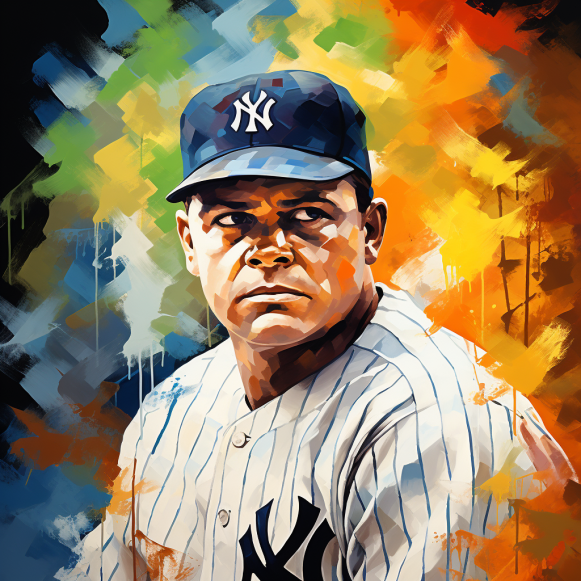A Baltimore paperboy collected an Orioles Babe Ruth baseball card in 1914. Soon, it will be auctioned for millions.

In 1914, a Baltimore paperboy sold newspapers on the city’s streets and streetcars for one or two cents each. Along the way, he collected baseball cards of Baltimore Orioles players who appeared in the newspaper that day.
He kept them for years, especially one of George Herman Ruth, a 19-year-old pitcher for the minor league Orioles, and eventually passed them down to his son. That Ruth card is now one of only a few that remain. It will soon be auctioned off for the first time since it was issued 109 years ago.
It’s expected to fetch several million dollars and could compete for the title of most expensive baseball card ever, which is currently held by a Mickey Mantle rookie card that sold for $12.6 million last year.
Archibald Davis, the 16-year-old paperboy at the time, grew up to play semi-pro baseball and later passed the cards down. Archibald’s grandson, Glenn Davis, recalled playing with them as a child in Towson in the 1950s and 1960s.
“Certainly, if we had known how valuable they would become, we would have handled them with more care,” Glenn wrote to The Baltimore Sun in an email.
In 2021, the Davis family sold the cards to a private collector after a century of ownership, including many years on loan at the Babe Ruth Birthplace and Museum in Baltimore. That collector is now auctioning it off starting Friday, in what is expected to be one of the most expensive cards ever sold.
To begin with, the 1914 Baltimore News Babe Ruth card is extremely rare. There are only ten known examples of each color, which were released in both red and blue. In comparison, the T206 Honus Wagner card, one of the most iconic and valuable cards of all time, has at least 50 examples.
Second, the card is Ruth’s first collectible as a baseball player, having been issued before he had ever played in a Major League Baseball game. At the time, he was listed as a “pitcher,” the position he first played for the Boston Red Sox before becoming a slugging outfielder for the New York Yankees, changing baseball and becoming one of the country’s first athlete celebrities.
The card will be on display in Baltimore again before the two-week, online-only auction begins: the Babe Ruth Birthplace and Museum hosted a showing of the card on Wednesday.
The card is the centerpiece of the fall catalog from Robert Edward Auctions. The auction house will begin bidding at $2.5 million, but it expects the card to fetch much more, likely becoming the second-most expensive card ever auctioned.
The only card to ever sell for more than $7.5 million is a Mantle rookie card that was in mint condition and was auctioned just last year. The Ruth card, according to Brian Dwyer, the auction house’s president, could fetch or exceed $10 million due to its scarcity and unique provenance, having spent a century with one family. He predicted that it would be many years before another of these 1914 cards became available for purchase.
“We believe that it has the potential to threaten the all-time record,” Dwyer told The Sun.
The Ruth card isn’t in mint condition, but Ruth’s legendary status in sports history may make it appealing to wealthy sports collectors, a hobby that has grown in popularity — and dollar value — in recent years.
Prior to the last few years, a card selling for millions of dollars was extremely rare. It’s becoming more common now.
“This is definitely rarefied air,” said Dwyer. “But if you look at all of the examples of cards that have commanded six, seven, 12 million dollars, none of them, in our opinion, has the significance of this Babe Ruth rookie card.”
Ruth’s last name is the only thing on the front of the simple card. He was in the process of acquiring his nickname, “Babe,” for his youth at the time the card was issued.
On the back, it advertises the 1914 Orioles’ schedule against other International League teams, including the Buffalo Bison, the Jersey City Skeeters, and the Montreal Royals (the team Jackie Robinson would eventually join after breaking MLB’s color barrier).
The 2 5/8-by-3 5/8-inch red card has spent much of the last quarter-century on display at the museum near Camden Yards, where it was first loaned by the Davis family in the 1990s. The Davis family decided to sell the card in 2021, despite an estranged relative challenging the family’s ownership, according to Glenn Davis.
The new owner, whose identity has been withheld by the auction house, agreed to keep the card on display at the museum until earlier this year.
The card is now in the care of Robert Edward Auctions in a secure, undisclosed location — “it is heavily fortified, we’ll put it that way,” Dwyer said — and will remain there until the auction ends on Dec. 3, when it will be sold to a new buyer. In addition to the Ruth card, Archibald Davis’s other 14 cards from 1914 will be auctioned off in separate lots.
One of the few other examples of the card, a blue one, has been on display at the museum since July (thanks to a loan from a different collector), and the one up for auction, a red one, will join it on Wednesday.
“We’re going to bring the Babe back to Baltimore and give collectors the opportunity to see both the red and the blue example together,” Dwyer went on to say, “so two of the 10 known will be together for a two-hour period.”
The museum’s director of external affairs, Katie Dick, described it as a “once-in-a-lifetime opportunity.”
The card must be protected by layers of high-security glass and motion detectors. The multimillion-dollar card, which Glenn Davis casually played with as a boy in Towson, has its own team of professional guards when it travels.
“This card has to have its own security detail,” Dwyer went on to say. “This card must be accompanied by armed security.” Think about any movie where there are armored cars and armored guards; this is worthy of that level of protection.”
People who want to see the card can do so by paying the museum’s regular admission fee ($13 for adults, $11 for seniors/veterans, and $7 for children). A tribute to the late Brooks Robinson is also on display, with one of his gloves, one of the first examples of a batting helmet worn by him, and his first contract with the Orioles from 1955.
Wednesday could be the card’s final public appearance for quite some time. However, Glenn Davis hopes that whoever is next able to lay claim to the card will consider making it available to others, as his family did.
“We hope that the future owner will consider having them available for public display,” he wrote in an email. “They are magnificent historical sports artifacts.” Something to be treasured by fans of the game of baseball.”




